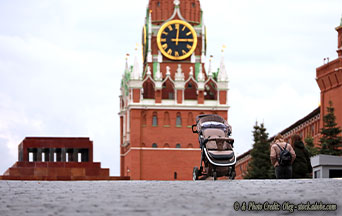Is Russia’s Declining Birth Rate a Global Warning Sign?
by Edwin Benson October 10, 2024 Russias-declining-birth-rate-a-global-warning-sign

Russia is weak and growing weaker every day. This evaluation is not directly related to the usual measures of national strength—wealth, military resources or occupied land—nor is it merely wishful thinking. Academics have a name for Russia’s core issue: demographics.
Recipe for Disaster
Demographics is the study of population and its change over time. Populations rise and fall for many reasons. Some classic explanations include religious beliefs, morality, health issues, economic opportunities, immigration and political conditions. However, two significant aspects are relatively new—effective contraception and legal abortion.
All of the classic and the more recent factors apply to the demographic disaster in Russia. The Russian Orthodox Church subordinates religious doctrine to political expediency. Russia’s public health is a disaster, as seen in the fact that male life expectancy declined to 57.4 years in 1994. (It is 67.5 today, far below that in the U.S—79.25.) The economy has been a shambles ever since the Bolshevik Revolution. During the decades of Communist rule, anyone who could arrange an exit visa left. Even today, the country is enough of a land of opportunity to attract mass immigration to make up for the low birth rate.
Moreover, the U.S.S.R. pioneered so-called “sexual liberation.” One of the first things that Lenin and Stalin did was to force women to work outside their homes. To smooth this revolutionary change, they promoted divorce and abortion. In the century since, these conditions have become universally accepted. Today, they are never even discussed.
Certainly, all other industrialized nations—the U.S. included—suffer under some of the same circumstances. However, only in Russia have all these conditions been so prevalent over such a long period.
Too Old to Fight?
Russia’s situation is desperate. Until it invaded Ukraine, some argued that Russia’s demographic issues undercut its capacity to fight a modern war. That idea has a name: “geriatric peace theory.” Despite its odd-sounding title, no one should dismiss it casually. The premise is that a nation with a rapidly aging population cannot mount a successful war.
Robert Farley, a visiting professor at the U.S. Army War College, explains, “Geriatric Peace Theory depends less on the actual availability of young men than on the socioeconomic structures that emerge in “old” societies, in particular the need for young workers to support the social safety net and health care systems that aging citizens require. This leaves fewer young people available to fill the needs of military organizations.”
However, Jennifer Sciubba, Ph.D., author of 8 Billion and Counting: How Sex, Death, and Migration Shape Our World, notes that old age does not always guarantee the peace. In a 2022 paper she prepared for the Population Reference Bureau, she spelled out her reservations.
“The safest argument, the one that leaves us best prepared for the future, is that population aging and depopulation are not an automatic recipe for peace. What Russia, China, Japan, and many other aging countries have shown is that when the threat level or motivation is sufficiently high, even states at the end of the demographic transition will marshal the resources to fight.”
Two Weak Opponents
How did these factors play out in real life? When Russia first invaded Ukraine in February 2022, most analysts predicted a swift Russian victory. When that did not happen, most credited a combination of Russian incompetence and unexpected Ukrainian resistance. However, no one should disregard demographic factors.
Indeed, Ukraine shares many of its adversary’s maladies. As a part of the former U.S.S.R., most of Russia’s Communist-created social, legal, and economic ills affected Ukraine as well. So, two fundamentally weak countries are fighting against each other. Both can carry on because they have strong allies.
Lots of ink has been spilled recording Vladimir Putin’s reactions to Russia’s low birth rate, which one of his spokesmen labeled “catastrophic.” Even though the Russian leader turned on his propaganda machine to promote larger families and backed up those efforts with economic incentives, the dire situation has not improved. According to the Russian government’s statistical agency, Rosstat, “From January to June of 2024, 599,600 children were born in Russia—16,000 less than the same period in 2023.”
A World Wide Issue
However, these conditions are not limited to formerly Soviet-dominated countries. Nor are they confined to Eastern Europe and Asia. Russia’s fertility rate, 1.41, is identical with Austria’s. Germany’s 1.46 isn’t much higher. Spain (1.16), Italy (1.24), Poland (1.29) and Greece (1.32) lag behind the Russians. Only France (1.79), Romania (1.71) and Turkey (1.63) exceed Russia to any significant extent. The U.S. rate is virtually identical to that of the French.1 Canada’s 1.33 barely surpasses Greece’s birth rate.
None of these nations meets the standard for natural population replacement, which the World Economic Forum places at 2.1.
Russia is tasting the bitter fruits of generations of anti-family policies. While the nations of North America and Western Europe are better off, the long-term forecast is still grim.
The cure is easy to understand but requires Solomon’s wisdom to implement. The population shrinks because people have lost the motivation and morality to have children. Only a moral and religious regeneration can renew what the last three or four generations squandered.
